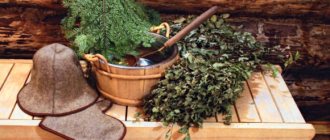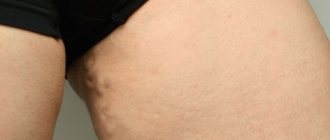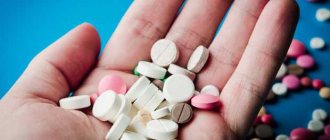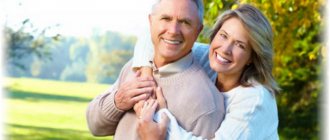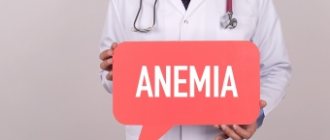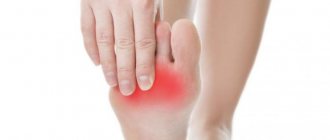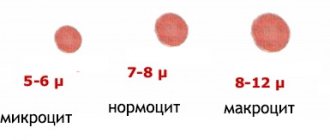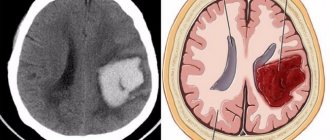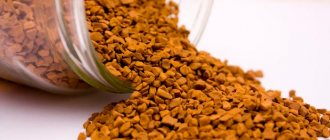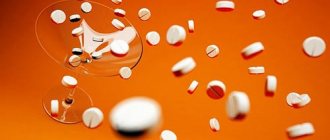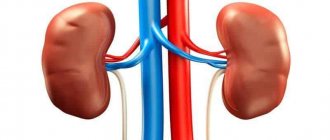Causes of varicose veins
Varicose veins are a dangerous and unpleasant disease; at a late stage of development, it is difficult to treat.
The reasons for the development of pathology may be the following:
- poor nutrition, excess body weight;
- venous valves are completely absent or damaged;
- hereditary predisposition;
- taking certain medications, for example, those containing hormones;
- weak venous walls from birth;
- sedentary lifestyle, most often this applies to office workers.
Varicose veins can appear during pregnancy. The thing is that during this period the veins in the pelvis are compressed. Reverse blood flow to the lower extremities is hampered, as a result of which the veins dilate and become overfilled with blood. To find out everything about treating varicose veins without surgery, read the article to the end.
Causes of varicose veins in women
First of all, I would like to note that among the causes and factors for the development of varicose veins, we can separately highlight the common ones, as well as those that are more common among the fair sex. If we talk about common factors, they are as follows:
- It’s not for nothing that they say that varicose veins are a disease of chefs and hairdressers. The most significant and common reason for the development of pathology is constant static loads on the legs. If a person stands a lot, the muscles do not relax, the legs get tired, and it is harder for the blood to circulate, rising up. All these factors together contribute to the development of varicose veins.
- Another factor, partially related to the previous one, is wearing uncomfortable shoes. We are talking not only about uncomfortable, disproportionate shoes, but also constantly walking on high or unstable heels, as well as wearing low-quality or old, worn-out shoes.
- Genetic predisposition – varicose veins are not inherited; we are talking about a predisposition to weakness of the venous valves. This predisposition can make itself felt over the years.
Uncomfortable shoes
- An overly passive, sedentary, and especially sedentary lifestyle also negatively affects the condition of the blood vessels in the legs.
- Also, very often the occurrence of varicose veins is provoked by excess weight. This is caused not only by constant excessive stress on the legs, but with obesity, cholesterol levels increase, which negatively affects the condition of blood vessels.
These are the main general factors predisposing to the development of pathology. However, this also includes bleeding disorders, diabetes mellitus, bad habits such as alcoholism and smoking, mechanical damage, etc.
As for the reasons why in most cases varicose veins develop in women, first of all we are talking about hormonal changes and disorders. Therefore, pregnancy can be called the main “female” factor.
Firstly, during pregnancy very serious hormonal changes occur; the content of progesterone in the blood increases and at the same time the concentration of estrogen decreases. This helps to increase blood clotting, as well as reduce the tone of the vascular walls due to a decrease in the synthesis of elastic and collagen fibers.
Secondly, the growth of the fetus in later stages of pregnancy puts pressure on the organs and, more importantly, the pelvic vessels, which makes the transport of blood through the veins to the heart somewhat more complicated. And finally, thirdly, as the weight of the fetus increases, physical stress on the legs increases, which, as you already know, also negatively affects the condition of the veins of the lower extremities.
Continuing the topic of hormonal imbalances, serious disorders can be caused by long-term use of hormonal drugs, as well as changes in the body during menopause.
Partner advertising
Symptoms of pathology
At an early stage of development, there may be no symptoms, but later patients may experience the following symptoms:
- there is a feeling of heaviness in the legs, pain occurs periodically;
- the veins in the legs become tortuous, dark blue or purple in color, so-called spider veins appear;
- even with a sedentary lifestyle, your legs get tired quickly;
- in the area of the ankles there are brown spots, the shade is uneven;
- cramps appear in the leg muscles;
- ulcerative defects appear on the skin of the legs or in the joint area;
- swelling, acute pain at the site of vein damage;
- veins become thick.
When the first signs of varicose veins appear, patients are advised to visit a phlegbologist. In the absence of timely treatment, an inflammatory process, thrombophlebitis, ulcers, eczema and other dangerous diseases can develop.
Dangerous symptoms
If certain symptoms appear, patients must contact a medical facility for examination:
- In the area of the affected limb, the pain is unbearable. Some patients note that they cannot get out of bed or take even a few steps.
- The skin on the affected area becomes hot, swells, and a thickening is felt upon palpation.
- Change in color, the skin becomes bluish or red.
- Weakened general condition, shortness of breath, difficulty breathing.
- Bleeding occurs from areas affected by varicose veins.
Each symptom is dangerous in its own way; to avoid complications, you should immediately visit the hospital.
Symptoms of varicose veins in women
Varicose veins develop slowly in women and require long-term treatment. The disease progresses, gradually circulatory disorders lead to damage to the valves and stretching of the walls of blood vessels. In the photo, signs of varicose veins in women's legs are visible to the naked eye.
Women suffer from varicose veins much more often than men, so they need to monitor the health of their circulatory system carefully, especially if someone in the family also has problems with veins.
The main symptoms of varicose veins in women on the legs:
- Manifestation of the capillary network;
- Night cramps in the calf muscles;
- Feeling tired in the legs in the evening: swelling, aching pain, burning;
- Veins appear on the surface of the skin;
- Tissue hyperemia, change in skin color: it may turn red, pale, or become cyanotic. Pigment spots may appear;
- In the advanced stage, trophic ulcers appear on the skin, which do not heal for a long time.
Important!
If symptoms of varicose veins are detected, it is important for a woman to immediately consult a phlebologist or vascular surgeon. An advanced form of the disease can lead to complications: blood poisoning, amputation and even death.
Compression therapy
Varicose veins in the legs can be treated without surgery using compression garments. The basis of therapy is the creation of pressure in the lower extremities. Venous circulation improves, valve function is restored.
With the help of therapy, you can eliminate numerous unpleasant sensations: cramps, swelling, etc.
- excess fluid is removed;
- venous pressure in the legs decreases several times;
- joints become more mobile;
- the rate of blood outflow increases.
A doctor prescribes compression garments.
Indications for therapy
Using this method, you can significantly alleviate the course of the disease and improve the patient’s condition.
Indications for this treatment:
- blood stagnates, its outflow is poor;
- gouty arthritis;
- stars on the legs;
- complications after surgery.
These methods of treating varicose veins without surgery are effective, but you need to prepare for the fact that they may not always be used.
The following can be considered contraindications:
- blood flow in the lower extremities is impaired;
- tissue damage: infections, inflammatory processes;
- vein thrombosis;
- the development of a disease such as heart failure.
Based on all these contraindications, compression garments should not be used under any circumstances.
Elastic bandages
Compression is a necessary measure used both for the treatment and prevention of varicose veins. Bandages are used after operations, as well as before they are performed. A certain pressure is created on the limb, due to which the blood can fully circulate and not stagnate.
In order to wrap a limb well, you will need at least five meters of material. All manipulations are carried out in a lying position; someone must help the patient. The toes should remain loose and the heels should remain closed.
The degree of tension should be medium, otherwise the leg will begin to go numb. Finally, the bandage is secured with a paper clip. At night it is removed, while the legs rest and breathe.
Compression jersey
You can replace the elastic bandage with special stockings. They affect problem areas in the same way.
As a result, you can achieve the following result:
- swelling is relieved;
- venous outflow improves;
- veins narrow in diameter;
- symptoms of varicose veins become less pronounced;
- further progression of the disease will be stopped.
You can wear stockings both as a preventive measure and for the treatment of varicose veins. Compared to a bandage, they are more convenient, but they are much more expensive. To achieve maximum results, you should put on stockings in the morning and take them off at night.
Important! They should fit the surface of the leg; to avoid irritation, moisturizer is first applied.
The video in this article clearly shows how to put on stockings correctly.
How to get rid of varicose veins
Prevention and treatment of varicose veins in women is an important component of health care. Timely measures taken to prevent the development of this disease can prevent significant health problems in the future.
This is especially true for pregnant women. Varicose veins in pregnant women are a very dangerous disease that can lead to disastrous consequences for both mother and child. That is why it is necessary to be constantly monitored at a family planning center throughout pregnancy and undergo all planned procedures.
If varicose veins are noticed in time, it is not difficult to, if not cure it completely, then at least stop its development. To prevent the occurrence of this disease, pregnant women are recommended to wear compression garments and a bandage.
Drug treatment makes the blood thinner, eliminates inflammation in the blood vessels, strengthens the walls of the veins and restores their elasticity. All these factors will help defeat varicose veins.
https://www.youtube.com/watch?v=hHyvt2fwcEc
Various ointments and creams help improve the condition of the skin, eliminate age spots and stars, get rid of complications and dermatological diseases caused by vasodilation.
Physiotherapeutic procedures also allow you to return the vascular system to a normal healthy state.
It must be remembered that only a medical specialist can prescribe adequate treatment for each individual patient, based on the stage of disease progression, concomitant diseases and complications, as well as contraindications related to the general health of the patient.
Drug treatment
Is it possible to cure varicose veins without surgery? It is difficult to get rid of the disease completely, but by implementing a set of many measures you can maintain a high standard of living.
Most patients are prescribed phletonics. The course of treatment and dosage is determined by the doctor, depending on the severity of the disease.
| Name | Description |
| The drug strengthens blood vessels, eliminates blood stagnation, and relieves swelling. The course of treatment lasts about six months. | |
| Increases vascular tone, reduces swelling. | |
| A special effect can be achieved by treating varicose veins at an early stage of development. Blood microcirculation improves. | |
| The permeability of the capillary walls decreases, the vessels become elastic and dense, and the inflammatory process is relieved. | |
| It is an anti-inflammatory and a good antioxidant. To achieve maximum results, it is recommended to combine with other drugs. | |
| The cream gives tone, relieves inflammation, strengthens venous walls. |
Lifestyle change
Methods for treating varicose veins without surgery involve a fundamental change in lifestyle. Many factors can provoke poor circulation in the legs: excessive physical activity, sedentary lifestyle, bad habits, etc. In order to restore vascular tone, a lot will have to change.
To do this, follow these short instructions:
- Normalize physical activity. Yoga, walking, fitness without much strength training, all this narrows the venous lumen and tones the vessels. If the lumen decreases, the valve will be able to fit tightly to the walls of the vessels, thereby preventing reverse discharge. At an early stage of the disease, sports exercises are vital.
- Organize rest and work. If you cannot avoid being on your feet for a long time, it is recommended to sit down and raise your legs up from time to time. Thanks to regular muscle contraction, vascular tone will be increased.
- Don't abuse bad habits. If the patient smokes and drinks in the near future, it will not be possible to avoid surgery.
Pay special attention to nutrition. When a person decides to treat varicose veins without surgery, what kind of food he eats plays an important role.
Products to be excluded from the diet:
- carbonated drinks;
- baked goods, sweets;
- smoked and fried foods.
You can replace sweets and cookies with honey, or better yet, with dried fruits. There are also other foods that you should not exclude, but rather eat as much as possible: seafood. They contain a lot of copper, which in turn has a tonic effect.
Hirudotherapy for varicose veins
How to cure varicose veins without surgery? Recently, treatment of the disease with leeches has been actively practiced.
Their benefits are as follows:
- has an anti-inflammatory and anti-edematous effect;
- blood microcirculation improves;
- the rheological properties of blood improve;
- improvement of cellular metabolism.
Substances contained in leech saliva prevent blood clotting; platelets cannot stick to the wall of blood vessels. Thanks to this, cellular metabolism improves.
After leeches are placed on the site of the lesion, enzymes begin to flow, they are aimed at strengthening the walls of blood vessels. The inflammatory process is relieved, the walls of blood vessels become more elastic.
We must remember the positive side of bloodletting. This process renews the bloodstream, the nutrition of tissues and organs improves.
Interesting! The leeches choose where to attach themselves. They simulate energy meridians.
How are the procedures carried out?
In order to cure varicose veins with leeches, you need to undergo a course of treatment consisting of at least seven procedures. For greater effectiveness and consolidation of the results, it is recommended to repeat the therapy periodically, at least three times a year.
There is no need to expect instant results. The body must respond to treatment, only after that the regeneration process will begin. Leeches are placed in a checkerboard pattern on each side of the diseased vein, the maximum distance from it is three centimeters.
The number of leeches on one leg should not exceed ten. The duration of the procedure, oddly enough, is controlled and determined not by the doctor, but by the leeches themselves. As soon as the time comes, they begin to detach from the skin. As practice shows, the procedure lasts at least half an hour.
At the end of the session, a bandage is applied to the treatment area, after which the doctor gives recommendations on how to properly care for the wounds. Before the next procedure, you need to fully rest.
It should be noted that leeches are aimed at stimulating the entire body, it rejuvenates. Patients feel much better, skin color and elasticity improve.
The photo below is an example of how leeches stick to sore spots:
Contraindications
The comprehensive effect allows the use of leeches not only for treatment, but also as a preventive measure. However, it must be taken into account that despite the effectiveness of hirudotherapy, there are some contraindications.
These include the following:
- there is a tendency to develop bleeding;
- women bear a baby;
- general condition is weakened;
- there are blood diseases;
- a person cannot tolerate leeches due to individual characteristics.
In addition, you need to remember that only an experienced doctor can carry out the procedure. Leeches must be medical grade; after one use they are destroyed.
Every patient should know how to get rid of varicose veins without surgery; the price of many methods is quite reasonable, which means they can be safely used. It is important to lead a healthy lifestyle, eat well, and drink enough fluids. Only with careful attention to your health can you avoid the development of many unpleasant diseases.
Varicose veins on the legs are a common problem, and the sooner treatment is started, the greater the chance of coping with this pathology.
Is it possible to cure varicose veins at home? How to remove veins in the legs without surgery and restore both the appearance of the legs and their health to normal?
Varicose veins: what is it?
Varicose veins are a consequence of circulatory disorders and congestive processes. It manifests itself with very unpleasant symptoms: swollen, swollen veins in the legs with a bluish tint, heaviness and pain in the legs, swelling, the appearance of a vascular “cobweb”.
Varicose veins are a disease that can have serious consequences, so at the first signs of varicose veins, you should consult a phlebologist.
Early diagnosis will allow you to begin treatment therapy and cope with the pathology. Otherwise, treatment of severe varicose veins on the legs may not have a positive result and the only way out will be to eliminate the problem surgically.
According to statistics, women are the main risk group . 67% of all cases of varicose veins occur among the fair sex. In addition to numerous health problems, women are also concerned about the aesthetic side - varicose veins look more than unattractive.
How varicose veins develop
Differences between healthy and varicose veins
Varicose veins are widespread, and this pathology is more common in women - women encounter unsightly nodes on their legs and heaviness in them 8 times more often than men. The number of cases directly depends on age - symptoms of vascular pathology are detected in 20% of young girls and 80% of older women who are over 60 years old.
In the age group from 20 to 50 years, complications are more often diagnosed, and it is these patients who are interested in whether it is possible to cure varicose veins forever and what medicine will help get rid of this problem.
It is important to understand: the direct cause of the appearance of altered veins is genetically determined abnormalities of the connective tissue, which lead to changes in its structure.
Appearance of varicose veins
Such a structure cannot provide both the extensibility and strength of the vessel, which leads to the development of varicose veins. The wall of a vein, unlike an artery, has practically no muscle elements that ensure normal tone and blood outflow. In the veins, fluid moves against the force of gravity, so additional force is required to move it, and this factor increases the likelihood of varicose veins.
A lack of collagen provokes vasodilation, and changes begin in the smallest venules, and gradually the main veins are involved in the process. In this case, trophic changes develop in the skin, and inflammation occurs in the tissues surrounding the affected areas - clinically such processes are manifested by the appearance of vessels that are noticeable upon examination, tortuous and painful on palpation.
Manifestations of varicose veins at different stages
Treatment methods for varicose veins
How to treat varicose veins on the legs? There are various methods on how varicose veins can be treated:
- Use of medicines. Pharmacy shelves are stocked with a large number of different creams, ointments for external use, as well as tablets and capsules that combat the problem from the inside.
- Ethnoscience. Treatment at home using old, reliable and proven methods can be very effective at an early stage of the disease.
- Sclerotherapy . Requires a procedure in a medical institution, but is not a surgical treatment method, since it is carried out with minimal damage to the skin. Refers to the main methods of how to treat varicose veins without surgery.
- Radiofrequency and laser correction . Modern methods of surgical treatment effectively fight not only the cause of the disease, but also eliminate the external manifestations of varicose veins.
- Phlebectomy . A radical method of eliminating the disease. Part of the damaged vein is surgically removed. In some cases, complete excision of the varicose vein is required.
Is it possible to cure varicose veins without surgery?
So, how to reduce varicose veins without surgery? If varicose veins are already progressing, you cannot do without medical help in any case.
Sclerotherapy
The most commonly practiced method of non-surgical elimination of varicose veins. A special drug, sclerosant, is injected into the damaged vein. With the help of a sclerosant, the vascular walls are restored, “glued,” nodules are eliminated, and blood flow is normalized.
In addition to the powerful effect on the direct cause of the disease, external defects are eliminated (vascular networks and swollen veins of a bluish tint clearly visible on the skin) and symptoms (pain, heaviness in the legs, swelling) are eliminated.
Laser and radiofrequency therapy
Two innovative methods, similar in both the method of implementation and the result. The procedure is carried out in a medical office using a laser or a special emitter. Thanks to therapeutic radiation, the affected veins are restored from the inside. Blood flow is normalized, all manifestations of varicose veins (discomfort, pain, heaviness in the legs, vascular “cobwebs”) are completely eliminated.
The procedures are carried out without direct contact with the legs, without any injections or incisions. The only thing that may be observed after the procedure is slight redness on the skin.
Rehabilitation period
The recovery period after sclerotherapy, radiofrequency and laser correction occurs in the shortest possible time.
3 hours after the end of the procedure, the patient can leave the medical facility and go home. After a day, you can return to your normal active lifestyle.
If we compare these treatment methods with phlebectomy, rehabilitation occurs many times faster. With complete surgical removal of the affected vein, the patient must spend at least a day in the clinic, after which a week of bed rest is required.
Treatment options
Thanks to modern technologies, treating varicose veins has become easier and more effective. The new procedures do not require surgery and can be performed without general anesthesia.
Doctors may treat with a laser, a special solution called sclerosant, or a combination of these methods. You will be able to go home after the procedure with minimal discomfort and pain.
- Laser therapy is a very effective procedure used on small varicose veins, performed on an outpatient basis, with a quick recovery time and positive, medium-term results.
- Sclerotherapy is a very effective, minimally invasive treatment method that involves injecting a special solution into a vein. This solution glues the vein together, and it disappears over time.
- Intravenous laser ablation is a highly effective, minimally invasive procedure that uses heat to treat the vein. Heating occurs using a laser or radio frequency wave. The veins should disappear within some time.
There are other procedures still used today, but they are much less preferred because they are more invasive, more complex, have many more potential side effects, and require a longer recovery time. These include:
- Phlebectomy is a procedure in which dilated veins are removed using special hooks through tiny incisions. This is a full-fledged operation, performed in most cases under general anesthesia. Possible side effects: bruising, hemorrhages, hematomas, sensation of “goosebumps”
- Stripping is a surgical procedure in which a vein is removed through small surgical incisions. The procedure takes about 1 - 2 hours, while the patient is under general or spinal anesthesia. After the procedure (most often), you will need to spend several days in the hospital under the supervision of a doctor, as well as reduce physical activity for several weeks. Complications associated with anesthesia or the operation itself are possible, for example, various allergic reactions, postoperative bleeding, infections, deep vein thrombosis, pulmonary embolism , etc.
If you want to avoid serious complications and side effects, choose one of the non-invasive or minimally invasive procedures. Such methods will help get rid of varicose veins in a shorter time, with minimal risk and, as a rule, with virtually no pain.
Treatment of varicose veins at home
There are also the most conservative methods for treating varicose veins. We are talking about how to treat varicose veins in the legs using pharmaceutical remedies and folk methods.
Ointments and creams
They are used externally and, by penetrating the skin, affect the veins affected by varicose veins. These products help relieve pain and swelling of the legs, strengthen the walls of veins and blood vessels, protect veins from the negative effects of free radicals, and reduce the permeability of cell membranes.
The following products for external use are considered the most effective:
- "Troxevasin";
- "Troxerutin";
- "Lioton";
- "Venoruton";
- "Venorm";
- "Sofia";
- "Eskuzan."
You can also use shark oil and heparin ointment.
This treatment method also has its drawbacks. First of all, there are a number of restrictions and contraindications (many of them cannot be used during pregnancy). It should be noted that ointments and creams for external use are effective only at the early stage of varicose veins.
Pills
Tablets are more effective than topical products because they act on the problem from the inside.
Systematic intake of tablets will strengthen the walls of veins and blood vessels, protect them from the formation of blood clots and nodules, normalize blood flow, and eliminate pain and discomfort in the legs.
The following drugs have been found to be effective:
Before use, consult a doctor! There are contraindications.
Capsules and tablets can help reduce the manifestations of varicose veins at an early stage, but in advanced cases, tablets cannot cope with it.
Traditional methods of treatment
Traditional medicine has long been used to improve well-being and help cope with disorders in the body. How to remove varicose veins on the legs using some traditional methods is described in the table:
| Method N°1 | Method N°2 | Method N°3 |
| Treatment with tomatoes. |
For maximum effect, it is recommended to choose green tomatoes. They need to be washed, cut into slices, applied to problem areas and secured to the legs with gauze or an elastic bandage.
It is better to do the procedure before bed, leaving the compress on overnight. In the morning, remove the bandages and wash your feet with warm water.
To prepare the infusion, you need to chop 4 lemons (with peel!) and 4 peeled heads of garlic. Place the resulting mixture in a jar or pan and add three liters of warm water.
Infuse for three days in a warm, dark place, stirring occasionally. Take half a glass three times a day.
It is necessary to prepare a medicinal cocktail from the juice of carrots, beets and spinach.
To enhance the effect, you can add finely chopped parsley. Drink 100 ml daily.
It is important to remember that folk recipes must be used in combination with medications prescribed by a phlebologist!
Measures aimed at strengthening the vascular wall
Taking into account all of the above, it is logical to assume that in order to prevent the progression of varicose veins, it is necessary to stop the process of deformation; this can be done by strengthening the vascular wall. Therefore, we will now look at various techniques to achieve this goal and improve the patient’s condition as a whole.
Apple vinegar
One of the most common and effective means for combating varicose veins, however, it is very important to use natural apple cider vinegar, and not use acetic acid with flavoring (both options are freely sold in stores, carefully read the description on the label). The recipes look like this:
- Immediately after the bath, simply pour vinegar on your legs where the veins are swollen, then wait until the liquid is absorbed, no need to wipe it off. This procedure will help get rid of the feeling of heaviness and pain.
- In a similar way, you can treat problem areas by rubbing vinegar with light massaging movements. It is better to do this not after a bath, but before going to bed.
- A very effective method is wraps - take gauze folded 2-3 times, dip it in apple cider vinegar, squeeze it lightly and apply it to problem areas. Then wrap your feet over the gauze with a towel, and wrap cling film on top. In this case, it is better to raise your legs above the level of your body. This procedure effectively eliminates swelling and unpleasant symptoms, lasts about 30 minutes, and there is no need to wash your feet after it.
Horse chestnut against varicose veins
Another extremely effective and famous remedy for combating varicose veins, for which there are many recipes, we will consider the most effective:
- Tincture with vodka or medical alcohol - for preparation you will need 50 grams of fruits cut into small pieces, right in the peel. Place them in a glass container, fill with 250 milliliters of alcohol or vodka, then close the lid tightly and leave in a cool, warm place for 14 days, remembering to stir occasionally. After the specified period, strain the tincture and take 15 drops before meals, three times a day, for 3 weeks.
- There is also a product for external use and to make it, 5 whole chestnuts and 5 tablespoons of inflorescences of this plant. Grind the indicated ingredients using a blender or coffee grinder, mix thoroughly with 500 milliliters of vegetable oil (sunflower oil is fine). Then soak the resulting mixture for 2 hours in a water bath, wait until it cools and store in the refrigerator in a glass container. The method of application is simple, rub the ointment 1-2 times a day into problem areas on the legs.
horse chestnut
Treatment of disease with the most accessible vegetables
Vegetables such as tomatoes, potatoes, cabbage, which can be actively used for external use, have long proven their effectiveness in the treatment of varicose veins. Treatment methods in this case are as follows:
- Tomato – cut several tomatoes into thin slices and place them on your feet in places where the swollen blood vessels are visible. Then wrap some fabric around your legs and wrap an elastic bandage loosely on top; the compress can be left on even overnight.
- Potatoes are the most democratic and at the same time very good method. You will need potato peelings, which also need to be applied to your legs with the light side down; you can simply apply an elastic bandage on top and do not remove the compress for 2-3 hours.
- Cabbage is used in a similar way to potatoes, but on the leaves of this vegetable, before applying them to your feet, you need to make many small cuts by running a knife along their surface. It is also recommended to lubricate the side of the cabbage leaf that is adjacent to the leg with vegetable oil.
Apitherapy
There is probably no industry in folk medicine where bee waste products are not used. Apitherapy means the use of propolis, honey, and beeswax. Since almost everyone has honey in their kitchen, let’s consider one of the best ways to use it for varicose veins:
- Take baking parchment and apply honey on it in a thin layer, literally no more than 2 millimeters. Then apply the honey canvas to the area of the leg where traces of varicose veins are visible and wrap it with cling film on top. The next layer of compress is fixed with an elastic bandage; it should be kept on the leg for about two hours. However, during therapy, which lasts 30 days, daily, in the absence of side effects on the skin, the application time is increased by an hour. Ultimately, the compress is applied all night and removed only in the morning.
Using laundry soap
Laundry soap is a natural product that, although it has an unpleasant odor, consists only of water, clay, sodium, as well as animal and vegetable fats. Thanks to this chemical composition, soap helps relieve swelling, inflammation, even eliminate spider veins and prevent the occurrence of trophic ulcers. You can fight varicose veins with laundry soap in different ways, but it is best to make ointments and make compresses:
- To prepare the compress, you will need to infuse 10 tablets of acetylsalicylic acid in 250 milliliters of vodka for 2 days (only in a glass container with a tightly closed lid). After 2 days, 25 grams of soap, cut into small pieces, are mixed in the resulting solution. Then soak gauze folded several times in the solution and place it on the problem area of the leg, hold for no more than 60 minutes. This method will relieve pain, relieve inflammation, and also eliminate swelling.
- Ointment - in addition to soap, this recipe includes vegetable oil (150 ml), propolis (100 g) and beeswax (100 g). Initially, grate 150 grams of soap, then pour sunflower or olive oil into the resulting shavings, then add propolis, honey and mix everything thoroughly. Now place the mixture in an enamel or glass container in a water bath and stir until the mass becomes completely homogeneous. Once the ointment is ready, place it in a resealable glass jar and store in the refrigerator for up to 3 months. Rub the ointment daily into those places on your legs where varicose veins are visible, it is better to do this before going to bed, and to avoid staining your underwear or things, tie the treated area with a bandage.
Benefits of acacia flowers
A tincture of white acacia flowers is very popular, which also effectively copes with varicose veins in the initial stages. To prepare it, take 100 grams of dried acacia blossom and pour the raw material in a glass container with 500 milliliters of vodka, then put it in a cool, dark place for 21 days, remembering to stir occasionally. As soon as the time has expired, add one piece of grated lemon to the tincture and leave for another week. The resulting tincture should be used to wipe your feet morning and evening in those places where varicose veins are located.
Stages of development of varicose veins
The formation of this pathology goes through several stages. In the process of varicose veins, the following stages are distinguished:
- Venous valves weaken and reverse blood flow is impaired.
- There is a slow increase in valvular insufficiency. As a result, a large volume of returned fluid accumulates and the organ stretches.
- Blood is retained in damaged segments of blood vessels. A stagnation phenomenon is formed, which slows down the speed of blood flow.
- After some time, this process affects neighboring areas and disrupts the nutrition of nearby tissues.
The choice of treatment method is determined by the stage of the disease: getting rid of varicose veins on the legs without surgery is possible only in the initial stages.
Establishing a lifestyle
Impaired blood flow in the lower extremities is caused by a sedentary or, conversely, too active life, lack of rest, and the presence of bad habits. To restore vascular tone, it is necessary to make some adjustments to your lifestyle:
- Dose the amount of sports activities. The optimal types of physical activity are swimming, yoga, fitness (without strength training), and walking. They increase vascular tone and narrow the lumens in the venous cavity. Exercising will help remove veins in the legs without surgery.
- Establish a mode of activity and calmness. If your professional activity requires prolonged sitting, when you return home, lie down for 20 minutes with your legs elevated. When standing for long periods of time, regularly shift from foot to foot. This helps contract the calf muscles, which increases vascular tone.
- To refuse from bad habits. Smoking and alcohol accelerate the development of varicose veins. After some time, the patient may require surgery.
The patient also needs to adjust his diet: give up spicy, fatty and fried foods, carbonated drinks, and baked goods; reduce the amount of sweets you eat. Seafood (mussels, squid, shrimp, seaweed), poultry and rabbit meat, liver, vegetables, fruits, cereals, and freshly squeezed juices help increase vascular tone.
Use of conservative treatment
The initial stages of the development of the disease do not imply the appointment of surgery on the veins of the legs. In order to get rid of the manifestations of the disease and restore the full functioning of the valves in the venous vessels, it is necessary to restore elasticity and tone to the vascular walls. Varicose veins can be cured at home in the early stages using conservative therapy. Conservative technique includes:
- Correction of diet;
- Lifestyle change;
- Wearing compression garments;
- Use of medications.
Diet correction
When treating varicose veins without surgery, you need to eat right. It is necessary to exclude from your diet:
- Spicy seasonings and sauces;
- Fried and fatty foods;
- Carbonated drinks;
- Sweet baked goods.
Harmful foods for varicose veins
It is recommended to include seafood in your diet:
- Squid meat;
- Mussels;
- Sea kale;
- Shrimps.
Note!
Seafood contains a large amount of copper, which has a positive effect on the tone of venous vessels. Doctors recommend including more plant foods and natural juices in your diet.
Lifestyle change
Increased physical activity or physical inactivity, as well as bad habits, cause microcirculation disorders in the lower extremities. A change in lifestyle contributes to the restoration processes of the tone of the vascular walls:
- Physical activity should be dosed - walking, as well as swimming, yoga, fitness without strength loads. In the first stages of the development of the disease, sports activities are one of the main methods of treating varicose veins in order to do without surgery;
- Proper organization of rest and work schedules. It is necessary to move your limbs as often as possible, even when staying in one position for a long time. It is advisable to make rotational movements with the foot. From time to time it is necessary to step from foot to foot, thereby causing contraction in the calf muscles;
- Quitting the use of alcoholic beverages and tobacco.
Wearing compression garments
Special elastic underwear is used for daily use. These can be special leggings or stockings. This type of therapy helps prevent further deformation of the walls of venous vessels, reducing the risk of the consequences of the disease.
Special underwear must also be worn after surgery, during the recovery period, in order to quickly resume blood flow in the operated limb.
Important!
Compression therapy is not an independent treatment method for varicose veins in the legs. It is only auxiliary to prevent negative consequences associated with impaired blood flow in the veins.
Treatment with medications
In most cases, when contacting a specialist, varicose veins are at a stage where medication cannot be avoided. Various ointments, balms and tablets help restore blood flow and increase tone in the veins. The following medications have an excellent therapeutic effect:
- Phlebodia;
- Troxevasin;
- Trocmerutin;
- Detralex;
- Lyoton.
Depending on the severity of the disease, vetotonics may be prescribed in tablets or injections. But the dosage and duration of therapy are prescribed only by the attending physician.
Note!
If there is a tendency to form blood clots, blood thinning drugs are prescribed, and for inflammatory processes in the veins, anti-inflammatory drugs are prescribed.
Drugs for the treatment of varicose veins
Treatment of varicose veins with folk remedies
In the first stages of the development of the disease, varicose veins can be treated using traditional medicine. For these purposes, various decoctions and infusions of herbs are widely used for oral administration, as well as ointments and tinctures for compresses and rubbing. Decoctions of plantain, chamomile and nettle are beneficial.
You can prepare a decoction of plantain herb and chamomile flower. The dry substance is taken in equal proportions and poured with boiling water. The resulting mixture must be put on fire in a container with a thick bottom and brought to a boil. After boiling, you need to remove the broth and let it brew for 8-10 hours. The infusion is filtered and taken 150 ml twice a day.
Compression clothing
Non-surgical treatment of varicose veins of the lower extremities can also be carried out using elastic underwear (stockings, leggings) and bandaging. Such underwear should be put on immediately after sleep, while lying in bed. Anti-varicose compression hosiery prevents subsequent stretching of the venous walls and reduces the level of negative consequences of the disease.
But it should be understood that this type of therapy is not independent. It must be accompanied by drug treatment and the right lifestyle.
Treatment of varicose veins with drugs
After the first signs of varicose veins appear, you should immediately consult a specialist. Vein and vascular doctor - phlebologist.
Drug treatment of varicose veins is complex. In the initial stages, when the dilation of blood vessels is still slight, the use of only external medications is sufficient. At later stages, it is necessary to use systemic agents.
Most of the drugs in the venotonic group are made on a plant basis, so they are safe and rarely cause adverse reactions. Such drugs include:
According to reviews from doctors and patients, with complex drug therapy, the healing process begins 3-4 days after the start of treatment, and when using ointments alone - after 1-1.5 months. For example, the following set of drugs can help cure veins in the legs: Phleboton gel (for external use) and Phleboton tablets (for internal use). But the most effective drug should be prescribed to the patient by the attending physician. Self-medication is not recommended!
Why veins appear - reasons
Often problems with veins in the legs are hereditary.
In this case, it is necessary to begin taking preventive measures as early as possible. But more often the appearance of this disease is provoked by concomitant diseases, hormonal changes, and unhealthy habits. An incorrect diet and excessive consumption of unhealthy, fatty, high-calorie foods cause an increase in the level of bad cholesterol. And the love for fast carbohydrates provokes surges in blood glucose levels.
Other causes of varicose veins in women include:
- hormonal changes associated with teenage and menopausal changes, pregnancy;
- work that requires prolonged sitting or standing, constant stress on the legs;
- lack of physical activity, passive lifestyle, excess weight.
Prolonged immobility in any position provokes stagnation of blood circulation. To avoid this problem, you need to periodically warm up and change your body position.
Important! Beautiful, but tight and uncomfortable underwear, narrow shoes with high heels can also lead to the formation of varicose veins.
Varicose veins of the lower extremities (LVLV) are a type of disease that not only causes a lot of discomfort for a person, but can also greatly spoil the appearance.
Meanwhile, this disease is a dangerous pathological condition that leads to serious damage to the circulatory system. Most often, middle-aged people, 30-40 years old, suffer from varicose veins of the legs.
ethnoscience
Varicose veins are a fairly old disease. People suffered from this disease several centuries ago. During this time, a large number of traditional medicine recipes were invented. The most effective of them are:
- Blue clay compresses. Clay is dissolved in water (liquid dough consistency). The bandage is dipped in the resulting mass and applied to the affected area for 30–40 minutes. Next, the clay is washed off with warm water.
- Compress made from grated new potatoes. The resulting mass is applied to the affected area and secured with a tight bandage. The compress can be worn constantly, but the filling should be regularly replaced with fresh ones.
- Chestnut tincture for varicose veins. There are two cooking methods. First method: Horse chestnut inflorescences are pre-dried. After this, the resulting raw materials are poured with vodka and infused for 7 days. The resulting infusion is used for compresses and rubbing.
Second method: unripe chestnut fruits are cut into small pieces. The infusion and use scheme is similar to the first recipe. This option is great for numbing damaged areas.
- Wormwood compress. To prepare 2 tbsp. l. fresh chopped herbs are mixed with a glass of curdled milk. A gauze bandage is moistened in the resulting mass and applied to the affected area. Keep on the skin for about 25–30 minutes.
- For internal effects, it is recommended to consume flaxseed or pumpkin oil (1 tablespoon), milk thistle fiber (1 teaspoon) in the morning on an empty stomach.
And despite the fact that such methods of treating varicose veins without surgery seem safe, consulting a phlebologist will not be unnecessary.
